Do It Yourself Auto Repair Garage
105 Easy DIY Car Repairs You Don't Need to Go To The Shop For
Vehicle repairs and maintenance tasks don't always have to be done in the shop. You can easily do these in your own garage.
1 / 105
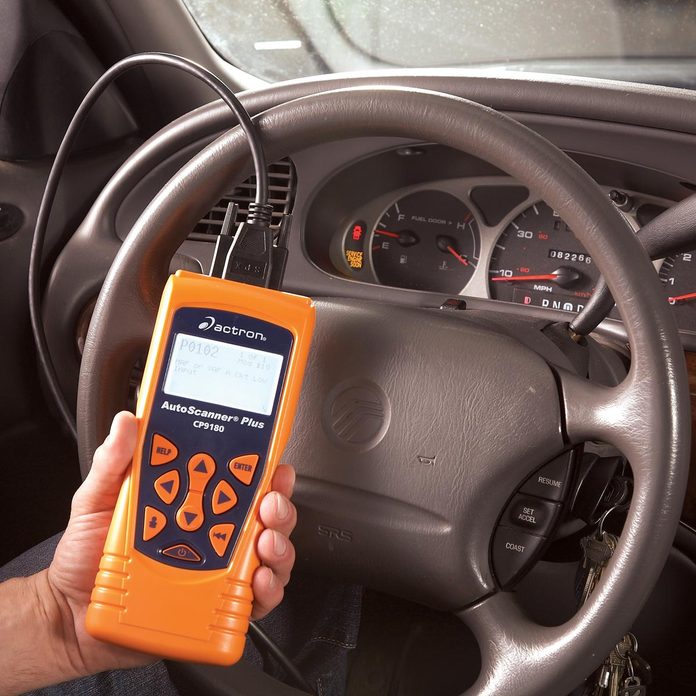 Family Handyman
Family Handyman
Use a Code Reader
Diagnose car problems without going to a mechanic with an auto code reader. Simply plug it into the car's computer system, then interpret the trouble code readout to see what repairs you might need to do. See how to crack the code of a code reader here.
2 / 105
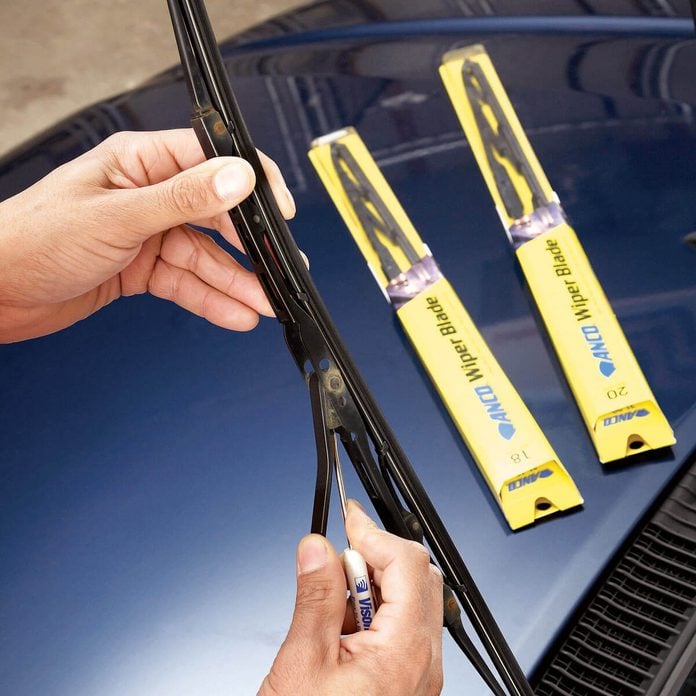 Family Handyman
Family Handyman
Replace Your Wiper Blades
It's easy to tell when your blades need replacing. Simply press the washer button and see if your blades wipe clean. If they streak, they're toast. The auto parts store will have lots of economy blades, but go with a name brand instead (ANCO, Trico or Bosch). They cost more than economy blades, but their higher-quality rubber wipes better, has better UV protection and lasts longer.
Follow the installation instructions on the package. Be sure you have a firm grip on the wiper arm once you remove the old blade. If it gets away from you, it can hit the windshield with enough force to crack it.
3 / 105
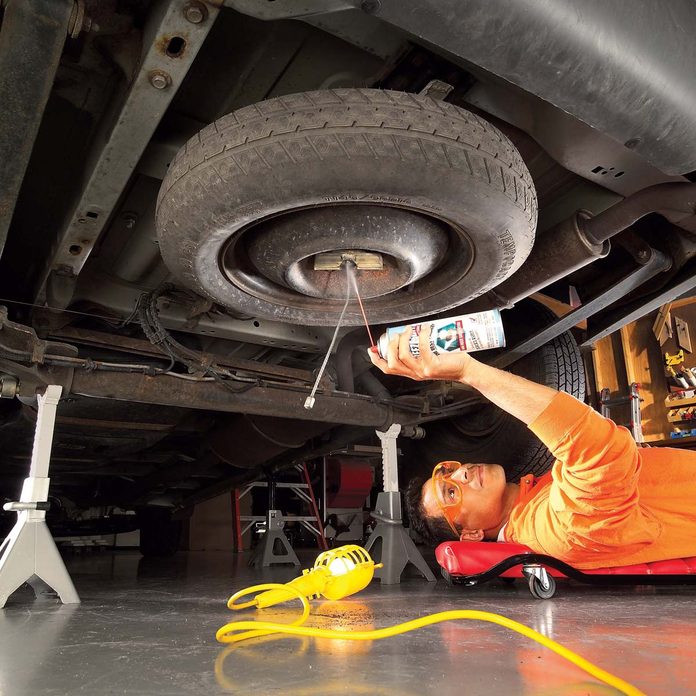 Family Handyman
Family Handyman
Service Your 'Tuck-Under' Spare Tire Lift Now!
Loosen and lubricate a corroded spare tire lift so you can get to your spare tire when you need it. See how to keep that spare tire lift loose so you can get the tire when you need it.
4 / 105
 Family Handyman
Family Handyman
Solve Rough Idle by Cleaning EGR Valve
Rough idle? A good dousing with throttle body cleaner may be enough to restore your EGR valve to near-mint condition, transforming a harsh idle into a soothing hum. Clean an EGR valve with these instructions for one of those easier car repairs.
5 / 105
 Family Handyman
Family Handyman
Fix a Leaking Valve Cover Gasket
Replace a leaky gasket cover on a 4-cylinder engine easily and in less than an hour for less than $25. We show you how to fix a leaky gasket here.
6 / 105
 Family Handyman
Family Handyman
Replace Sway Bar End Links
Fixing a clunk when your car hits a bump is a trial and error process. Start with the stabilizer bushings and then the bar end links, using a special tool. Replacing sway bar links is way cheaper than you think, see how to replace sway bar links and how much it costs.
8 / 105
 Family Handyman
Family Handyman
Replace Headlights
The hardest part of the job is choosing a new bulb. You can spend more time shopping for the bulbs than it takes to install them. The choices are mind-boggling. Every bulb manufacturer has its own confusing names for each style, making comparisons difficult. But it boils down to four upgrade categories—brightness level, life span, light color and energy consumption. See which bulb to pick and how to install a new headlight.
9 / 105
 Family Handyman
Family Handyman
Fix a Stuck Power Antenna
Fix a stuck power antenna by replacing a burned out motor or bad cable/mast. You can do both in about two hours, and you'll avoid the $50 – $100 dealer service fee. You need only one special tool, an antenna wrench. See how to fix an antenna here.
10 / 105
 Family Handyman
Family Handyman
Fix a Horn Problem
Use a simple fused jumper to pinpoint the problem with a bad horn. Often the fix is simple and cheap. Check out how to fix a car horn here.
13 / 105
 Family Handyman
Family Handyman
Replace a Thermostat
Replacing a car's thermostat (or T-stat) is an easy and inexpensive repair, and in most cases will cure an overheating or no-heat problem, sparing the time and expense needed for expert diagnostics. Learn all the steps to replace a thermostat here.
15 / 105
 Family Handyman
Family Handyman
Clean Your Air/Fuel Intake System
Do you get a crummy idle or poor engine response when you put the pedal to the metal? You may have soot and carbon buildup on the valves, intake manifold and throttle body assembly, as well as clogged fuel injectors. Shops charge $80 and up to perform a fuel induction cleaning service. But you can do the same thing in about 30 minutes with the 3M No. 08963 Do-It-Yourself Fuel System Tune-Up Kit; $35 from amazon. com. Watch the instructional DVD. Then grab the kit, a screwdriver, goggles and rags and you're ready to bust crud.
16 / 105
 Family Handyman
Family Handyman
Fix Your Power Door Locks
Repair broken power locks by replacing the actuator, which is a common problem on late-model Fords. You'll save on the shop fee plus some of the new part cost. Find out how to fix power door locks, you could save up to $100.
17 / 105
 Family Handyman
Family Handyman
Replace a Broken Wheel Stud
Tightening lug nuts without a torque wrench can be a recipe for disaster. If worse comes to worse and you break the wheel stud, here's how to replace it.
19 / 105
 Family Handyman
Family Handyman
Recharge Your Car's Air Conditioner
Improve the cooling of your car's air conditioner with an easy-to-use A/C recharge kit. You can do it in four simple steps.
20 / 105
 Family Handyman
Family Handyman
Change Your Spark Plugs
Change your spark plugs yourself to maintain peak performance and high gas mileage. In most cases it's a simple job as long as you have the right tools. See how to replace spark plugs.
21 / 105
 Family Handyman
Family Handyman
Replace a Serpentine Belt
Automatic belt tensioners, standard in most cars now, make changing a serpentine belt a simple DIY repair. Check out how to replace a serpentine belt in about 15 minutes.
22 / 105
 Family Handyman
Family Handyman
Refinish Wheels and Wheel Covers
Sometimes a middle-aged car can still look fine except for wear and tear on the wheels and wheel covers. Fortunately, you can fix this yourself for little cash. Removing the rust and painting your wheels take a full day. (Don't panic—mostly you're waiting for paint to dry.) Then the wheels must dry for 24 more hours after painting before you remount them. So make other arrangements for transportation for a day. The supplies cost about $50 from any auto parts store. See how to refinish wheels at home.
23 / 105
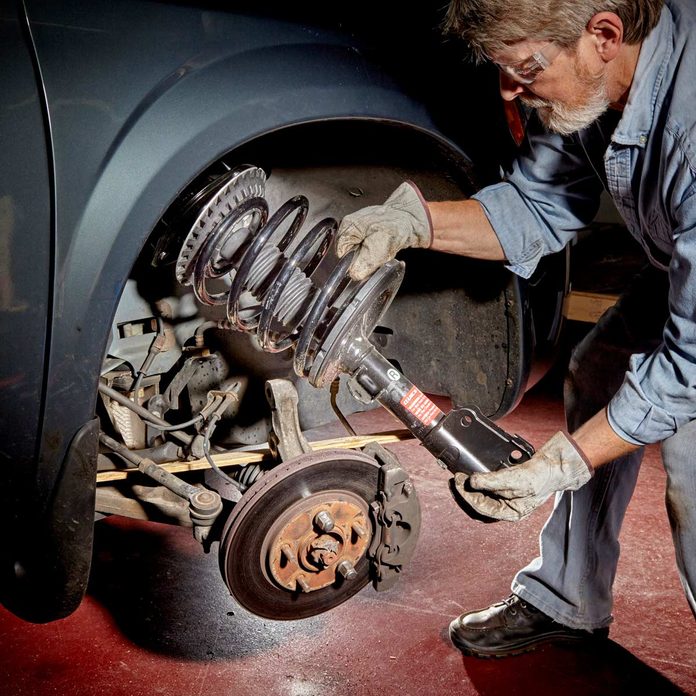 Family Handyman
Family Handyman
Replace Struts Yourself
If you've put 80,000 or more miles on your struts, they're worn out and must be replaced. We know they're expensive (about $700 for front struts replaced at a shop). But in the long run, driving on worn struts actually costs you more. You could save $300 doing struts yourself, see how to do it.
24 / 105
 Family Handyman
Family Handyman
Replace a Pickup Bumper
A rusty or dented bumper can drag down the whole appearance of a pickup that's in otherwise good shape. Having it replaced by a pro will set you back $1,000, but you can save $500 or more in labor and parts by doing the job yourself. It takes only a few hours. Get complete instructions here.
25 / 105
 Family Handyman
Family Handyman
Free Up a Sticking Hood Latch
If your hood doesn't latch and unlatch easily, chances are it's just rusty and dry. You can fix the problem in about 10 minutes with spray rust penetrant and spray lithium grease. Pop the hood and saturate the entire latch mechanism with rust penetrant. Latch and unlatch the hood several times until the mechanism works smoothly. The rust penetrant won't last long, so you'll have to apply a better lube. Open the hood and spray all the moving parts with white lithium grease. Latch and unlatch the hood several more times and you're good to go. There is a difference between rust penetrant and WD-40, which is still great at scaring away spiders, believe it or not.
26 / 105
 Family Handyman
Family Handyman
Free Up a Stuck Trailer Hitch
When the ball mount on your trailer hitch is rusted in place, don't whack at it with a sledgehammer. Here's what to do instead. Buy a can of penetrating oil ($6) and an air chisel fitted with a "hammer" bit. The air chisel will run about $15 and the extra bit will be about $8. Spray the opening to the hitch receiver. This newest style of penetrating fluid chills the metal, causing it to contract to help break the rust seal. Then use an air chisel fitted with a hammer bit to knock everything loose. The air hammer will break up the rust, spread the penetrant and free up the ball mount. Once it's free, just tap out the rusted ball mount with a regular hammer. If you plan to reuse the rusty mount, coat it with a rust converter or waterproof marine grease. Check out these great trailer upgrades!
27 / 105
 Family Handyman
Family Handyman
Change Your Engine Coolant
You can change your coolant yourself in about an hour. You'll need to invest in an air-powered refilling tool to remove air pockets from the cooling system as you fill. You'll save about $50 on your first coolant change and about $100 on each one after that. Check out how to change your engine coolant here.
28 / 105
 Family Handyman
Family Handyman
Remove a Stubborn Oil Filter
We've all done it—overtightened an oil filter so much that it's a bear to remove. If you think you can remove it by jamming a long screwdriver through the can and twisting, think again. The screwdriver will just rip the can open and you'll be drenched in oil. When you're done dealing with that mess, the filter will still be stuck and you'll be even more frustrated. To remove a stuck filter, use a band-type wrench that you've lined with coarse-grit adhesive-backed sandpaper. Learn what you need to know about changing your oil filter here.
29 / 105
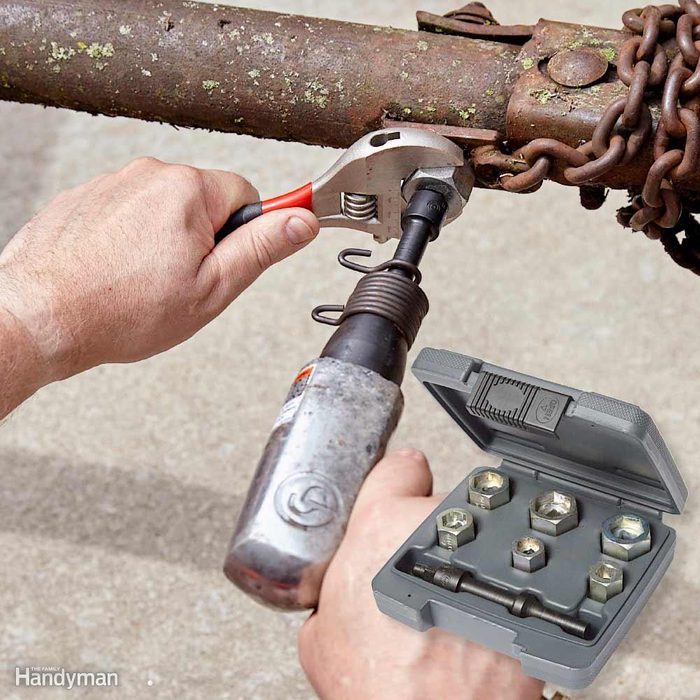 Family Handyman
Family Handyman
Blast Off Seized Bolts
This tool and a can of rust penetrant are the secret to removing stubborn rusty seized bolts. Load the driver tool into your air hammer and slide on a socket and wrench. When you hit the trigger, the driver applies the impacts to the center of the bolt head, demolishing the rusty buildup. Turn the wrench and socket during the impacts and you'll loosen the bolt or nut in no time.
30 / 105
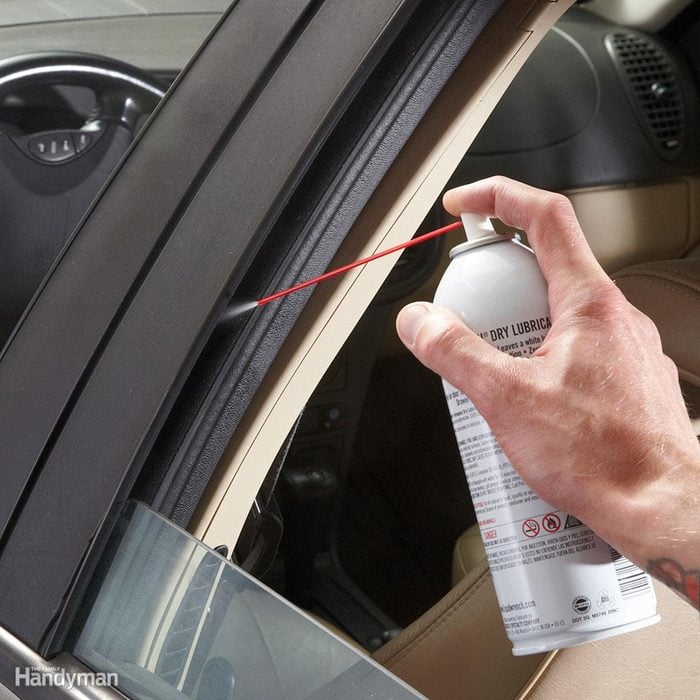 FAMILY HANDYMAN
FAMILY HANDYMAN
Lubricate Window Tracks
Freezing water can seep into the window tracks and create drag when you try to open the window. That drag can damage the window regulator cables, costing you almost $300. You can avoid the problem entirely by lubricating the window tracks with spray silicone or dry teflon spray lubricant. Lower the window and shoot the spray right into the front and back window track. Apply enough lube so it drips all the way down the track. Then operate the window through several open and close cycles to spread the lube along the entire track. Use glass cleaner and a paper towel to remove any spray that lands on the glass. Want more in-depth advice? Plus: Learn how to fix a leaking sunroof here.
31 / 105
 Family Handyman
Family Handyman
Swap Out Brake Fluid
Some carmakers recommend replacing brake fluid every two years or 24,000 miles. Others don't mention it at all. But it's easy to test your brake fluid. Just dip a test strip into the fluid and compare the color to the chart on the packaging.
You can't do a complete brake fluid flush yourself, but you can do the next best thing—a fluid swap. This procedure won't replace all the old fluid with fresh, but you'll introduce enough new fluid to make a difference.
Use a baster to suck out the dark brown brake fluid (brake and power steering fluids are incompatible, so use a different baster for each). Squirt it into a recycling bottle. Refill the reservoir with fresh brake fluid as shown. Then drive the vehicle for a week to mix the new fluid with the old. Repeat the procedure several times over the next few weeks until the fluid in the reservoir retains its light honey color.
Note:The brake fluid may damage the baster's rubber bulb, so don't suck the fluid all the way into the bulb.
32 / 105
 Family Handyman
Family Handyman
Change Power Steering Fluid
There aren't any test strips for power steering fluid, so you'll have to rely on the manufacturer's service recommendations or general rule-of-thumb (two years or 24,000 miles). Use the turkey baster method to remove the old power steering fluid. Suck out all the fluid (engine off) as shown. Then refill the reservoir with fresh fluid. Start the engine and let it run for about 15 seconds. Repeat the fluid swap procedure until you've used up the full quart.
Note:Never substitute a "universal" power steering fluid for the recommended type, and never add "miracle" additives or stop-leak products. They can clog the fine mesh filter screens in your steering system and cause expensive failures.
33 / 105
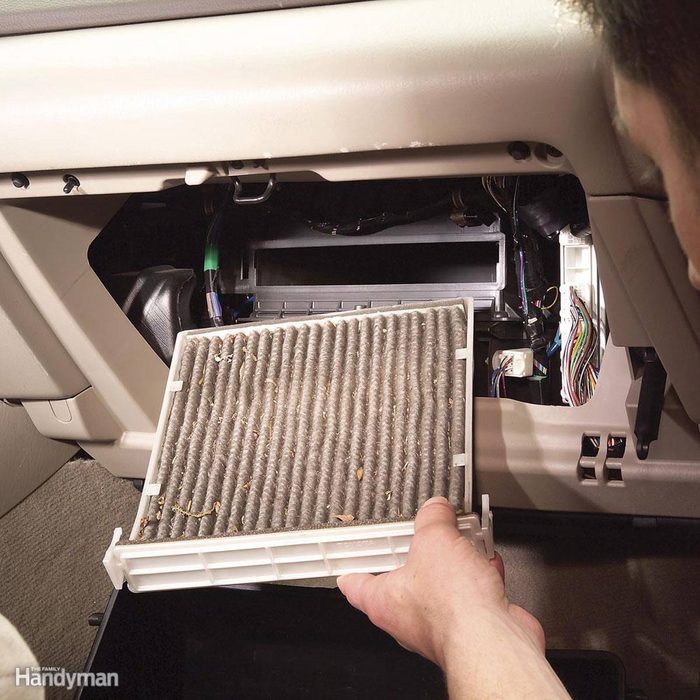 FAMILY HANDYMAN
FAMILY HANDYMAN
Replace Your Cabin Air Filter
A clogged cabin air filter can damage your car's blower motor and cause your AC to run longer and harder in the summer. Cabin air filters are easy to access and replace and you'll save about $30 by doing it yourself. It's one of at least 100 car maintenance tasks you can do on your own. Buy a replacement cabin air filter at any auto parts store and ask the clerk to print out the installation instructions. Cabin air filters are usually located in the air ducts behind the glove box in late model vehicles. However, some car makers locate them in the cowling or console area. Just remove the access covers and slide out the old filter. Note the direction of the airflow arrows so you can install the new filter in the proper orientation. Then reinstall the covers and you're done. See how to remove and replace your cabin air filter here.
34 / 105
 Family Handyman
Family Handyman
Fix Tears in Leather and Vinyl
Upholstery shops charge almost $200 to fix tears in your seats. You can do it yourself in a few hours with a vinyl and leather repair kit (less than $20) from any auto parts store. You'll have to practice a bit to get the right color mix and it might not be a perfect match when you're done, but it's a heck of a lot better than driving around with torn seats. Start by gluing reinforcing fabric onto the underside of the torn vinyl or leather. Then mix the heat-set filler to match your fabric color and apply it to the tear. Next, find a textured mat that most closely resembles the texture of your vinyl or leather and place it onto the liquid filler. Heat the patching tool with a clothes iron and press it onto the textured mat. Remove the patching tool, but leave the textured mat in place until the patch cools. Then peel it off. Learn more about the step by step process of leather repair.
35 / 105
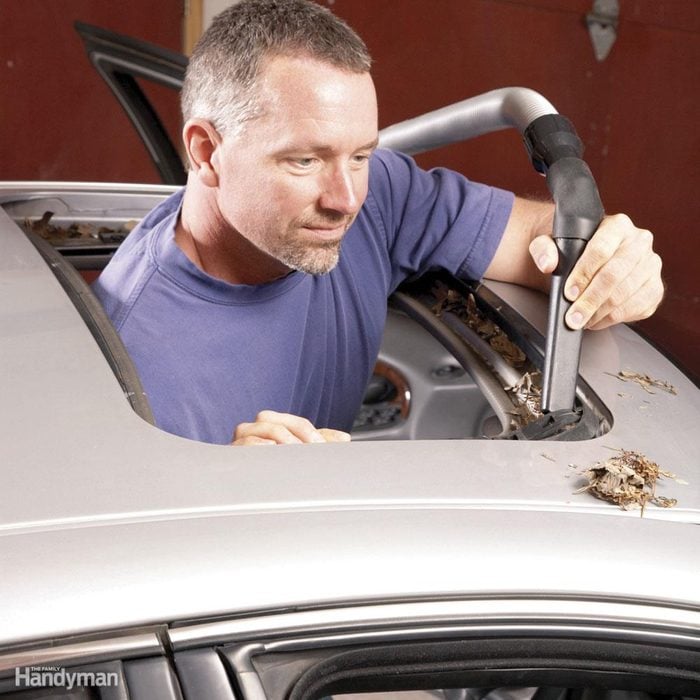 Family Handyman
Family Handyman
Fix That Leaky Sunroof
If raindrops keep falling on your head, it's probably because your sunroof drains are clogged. That's something you can fix yourself in just a few minutes. Open the sunroof and look for drain holes in the front and rear corners of your sunroof. Once you locate the drains, duct tape a small rubber or plastic tube to the end of your shop vacuum and suck out any debris stuck in the drains. Then dribble water into each drain and check under the car to see if it's draining onto your driveway or garage floor. If the drain is still plugged, buy a speedometer cable from an auto parts store. Insert the cable into the drain and gently push it down the drain as you spin the cable with your fingers. Don't push too hard because you can puncture the drain tubes and they'll dump water into your dash area. Flush the drain after snaking it with the speedometer cable. If it now runs free, you're done and shouldn't have any more water coming inside your vehicle.
36 / 105
 Family Handyman
Family Handyman
Replace That Broken Antenna
Replacing a fender mount antenna mast is easy. Just unscrew the remaing portion of the mast and buy a replacement mast at any auto parts store. Replacing a pillar mount antenna is a bit more involved but is still a DIY fix. Disconnect the antenna cable from your radio and connect heavy string to the end. Then unscrew the antenna mount from the pillar and pull the old antenna and the string straight out. Attach the new antenna cable to the string, pull the cable back into the vehicle and connect it to your radio. Then secure the new antenna to the pillar using the screws provided. Get step-by-step replacement instructions here.
37 / 105
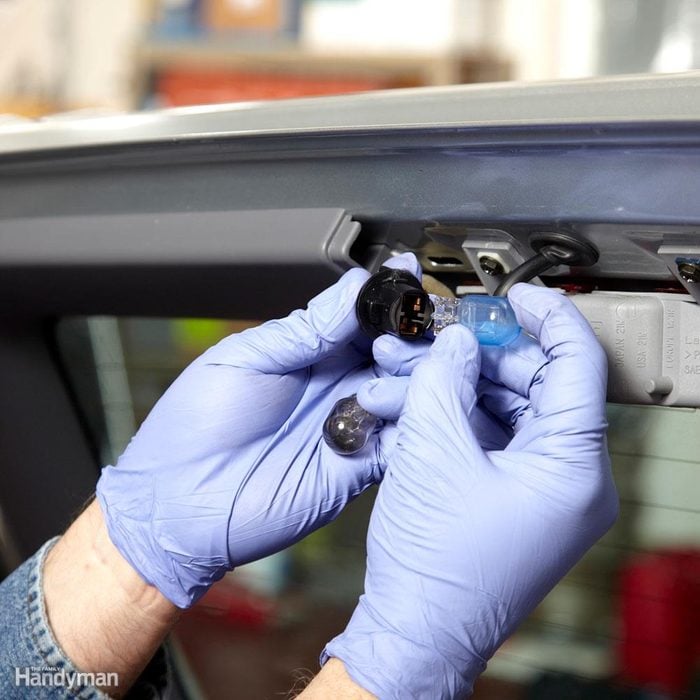 Family Handyman
Family Handyman
Replace Non-Headlight Bulbs
To access burned out license plate, side marker and fog light bulbs, just remove the retaining screws and pry off the lens. Pull the bulb straight out of the socket. Handle the new bulb with gloved hands or hold it with a paper towel to prevent skin oils from depositing on the thin glass — that can cause premature bulb failure. Then push the bulb into the socket until it clicks. Reinstall the lens and you're done. Get more info on changing auto light bulbs here.
38 / 105
 Family Handyman
Family Handyman
Gas Lifts
Why risk your noggin when you can replace gas lift cylinders yourself? Just buy new lifts at any auto parts store. Then have a helper hold the hood or liftgate while you disconnect and replace the worn lifts. Many styles simply unbolt using a metric socket set. Others connect with a ball and socket style connection held in place with a spring clip. To disengage the spring clip, simply shove a small flat blade screwdriver between the clip and the cylinder. Then pull the cylinder off the ball stud. Get the step-by-step guide for replacing your gas lifts here.
39 / 105
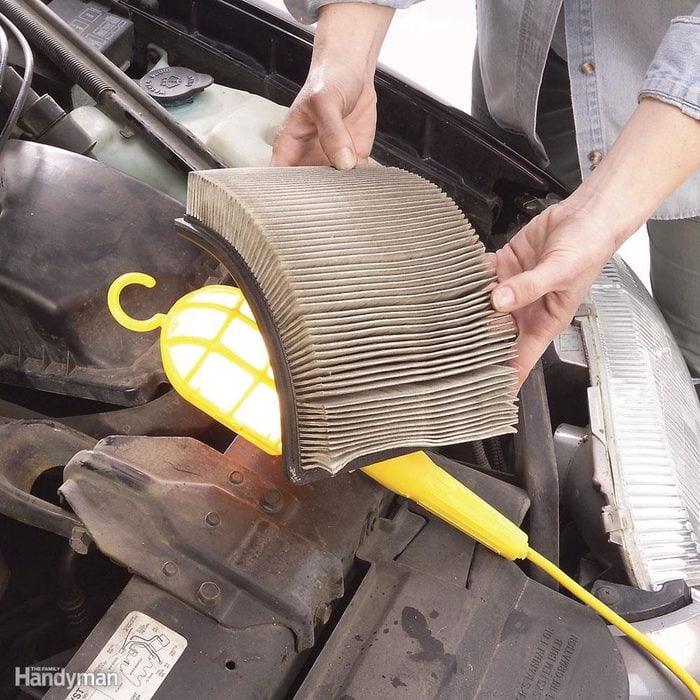 Family Handyman
Family Handyman
Replace Engine Air Filter
Inspect and replace your engine air filter. Just unscrew or unclip the air filter box retainers and remove the old filter. Then hold a shop light behind the filter to see how much light passes through. If the filter blocks 50 percent of more of the light, replace the filter. If not, put it back in, secure the air filter box cover and keep driving. Get the full step-by-step on changing your air filter here. It's one of the easier things you can do to fix up cars.
40 / 105
 Family Handyman
Family Handyman
Repack Trailer Wheel Bearings
Repack trailer wheel bearings to prevent the most common breakdown. It's an easy and cheap maintenance chore. Check out how to repack trailer wheel bearings here.
43 / 105
 Family Handyman
Family Handyman
Check the Level of the Electrolyte
Gently pry off the covers of the battery cells. The water and acid mixture in the battery (electrolyte) should be about 1/2 in. deep or to the bottom of the fill hole. If it needs water, use clean distilled water, being careful not to overfill the cells, and then inspect the battery case for cracks. If you find a crack, replace the battery. If you added water, let the water mix with the electrolyte for a few hours before the next step. (You may need to reconnect the battery to maintain your memory functions.) Check out more battery care tips here.
45 / 105
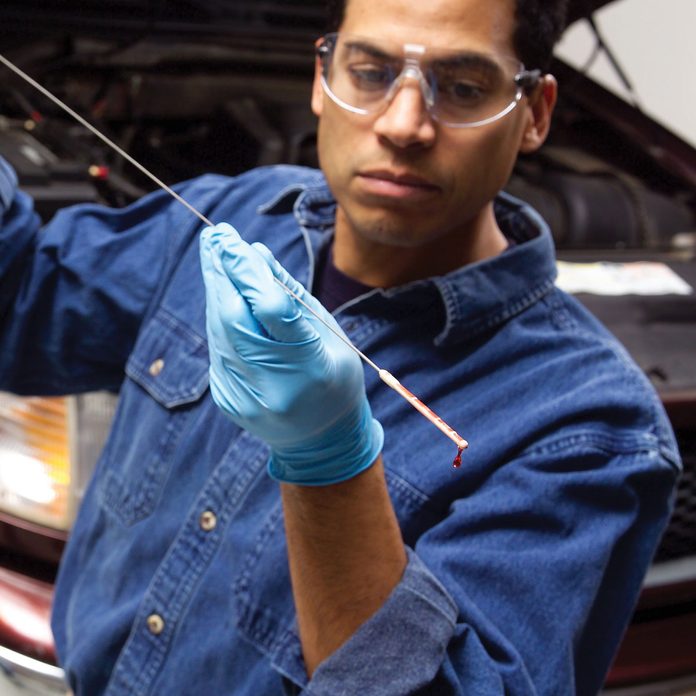 Family Handyman
Family Handyman
Change Your Transmission Fluid
Extend the life of your engine by changing transmission fluid. It's much easier by using a special transmission fluid pump, and you'll save $100 in shop costs when you do it yourself. We show you what you need and how to do it.
46 / 105
 Family Handyman
Family Handyman
Check the Blend Door Actuator
Does your car heater just blow cold air when you turn on the fan? It might be as simple as recalibrating the heating system or replacing the actuator. We'll show you how.
48 / 105
 Family Handyman
Family Handyman
Fix a Dirty Mass Air Flow Sensor
Clean your MAF (Mass Air Flow) sensor when it's dirty rather than replace this $300 part. It's quick and easy.
50 / 105
 Family Handyman
Family Handyman
Change a Flat Tire
Knowing how to change a flat tire on a car is an essential life skill. Flat tires usually come with little or no warning and they often happen at the worst possible time. This video gives you tips and tricks for fixing a flat tire that make the job safer and easier on your knees. Watch the video and next time you have a flat tire, you'll know what to do.
51 / 105
 Family Handyman
Family Handyman
Fix a Leaky Tire Valve
Fix a leaky tire valve in five minutes using an inexpensive valve core tool and replacement cores.
54 / 105
 Family Handyman
Family Handyman
Fix a Bad Engine Coolant Temperature Sensor
See the crack? This sensor didn't set off a trouble code or "check engine" light. But the owner had to pump the pedal to keep the engine running.
The computer in every fuel-injected car must know two things before it can figure out the correct cold-start air/fuel mixture: the engine coolant temperature and the outside air temperature. Your symptoms are a dead ringer for a bad engine coolant temperature sensor (ECT). The computer is calculating an air/fuel mixture that is too lean. That's why pumping the gas pedal keeps your engine running. You can have a bad sensor even without a "check engine" light or trouble code. They're so cheap (about $15) and easy to replace, that it makes more sense to just replace it. Ask the auto parts store clerk to find the right sensor for you (you may have two—one for the computer and one for the temp gauge on your dash) and to show you where it installs on your engine. Check out how to replace the coolant temperature sensor here.
55 / 105
 Family Handyman
Family Handyman
Clean the Ground Cables
Ground cables tend to corrode and cause various electrical malfunctions. A simple cleaning will clear up many problems. Here's how.
60 / 105
 Family Handyman
Family Handyman
Replace a Transfer Case Shift Motor
Diagnosing a shift motor problem is easy. Refer to a shop manual wiring diagram and follow the procedure for checking for power at the motor. If the motor is getting power but not responding, replace it. It takes less than an hour, and if you use an after-market replacement motor, you can save almost $200 by doing the job yourself. Check with an auto parts store, dealer or online for replacement motors.
61 / 105
 Family Handyman
Family Handyman
Change Transfer Case Oil (four-wheel drive only)
The transfer case is located at the rear of the transmission, and its job is to "transfer" power to the front and rear drive axles when you shift into four-wheel drive. But the gears inside the transfer case spin even when you're in two-wheel drive. So it's important to change the oil on schedule, even if you don't use four-wheel drive very often. Here's how to do it.
63 / 105
 Family Handyman
Family Handyman
Fix a Blower Motor
Restore multiple speeds to your auto heater/air conditioner blower by replacing a resistor module. It's a simple, quick change-out.
64 / 105
 Family Handyman
Family Handyman
Fix Bad Boat and Utility Trailer Light Wiring
Be a safe driver. We show you how to diagnose and fix trailer lights that are dim or don't work. Most fixes are quick and easy.
66 / 105
 Family Handyman
Family Handyman
Repair a Broken Car Window
A broken power window can be an expensive repair, but if you have basic auto repair tools and access to an online service manual you can fix it yourself and save big bucks.
67 / 105
 Family Handyman
Family Handyman
Replace a Broken Side Mirror
Replacing a broken side view mirror is easier and cheaper than you might think. Once you have the right tools, the hardest part is just finding the hidden fasteners. Here's how to do it.
70 / 105
 Family Handyman
Family Handyman
Replace a Broken or Missing Spoiler
The plastic air dam (aka "spoiler") that's broken or missing wasn't just for a sporty look. If your car had an air dam, driving without it or with a damaged one can reduce your gas mileage. The air dam literally "dams off" airflow to the undercarriage of your car, forcing the air up and over the hood. That helps your car cut through the air with less drag. It also increases airflow to the A/C condenser and radiator, reducing the load on your car's electrical system. Contact a junkyard or visit certifit.com to get a replacement air dam. Here are some other tips on how to save money on gas.
71 / 105
 Family Handyman
Family Handyman
Replace Your Oxygen Sensor(s) Before the Light Goes On
Oxygen sensors monitor the efficiency of combustion by tracking the amount of oxygen remaining in the exhaust. But they degrade over time and that can cost you up to 15 percent in gas mileage. When they fail, the computer lights up your "service engine soon" light, forcing you to incur an $80 diagnostic fee. On pre-1996 vehicles, replace your oxygen sensor every 60,000 miles to keep your mileage at its peak. On 1996 and newer vehicles, replace the sensors every 100,000 miles. Oxygen sensors cost about $60 each. Some vehicles have as many as four, but the sensors installed behind the catalytic converter rarely fail.
73 / 105
 Family Handyman
Family Handyman
Add a Window Coating
Research has proven that glass treatment products can improve your view through your windshield in rainy weather by as much as 34 percent. The improved vision can increase your response rate by up to 25 percent. That could mean the difference between avoiding an accident or being part of one. Here's how to add a window coating.
75 / 105
 Family Handyman
Family Handyman
Fix Up a Rear Window Defogger
Fix your rear auto window defogger quickly and easily with an inexpensive repair kit. No special skills needed, we'll show you how to do it.
77 / 105
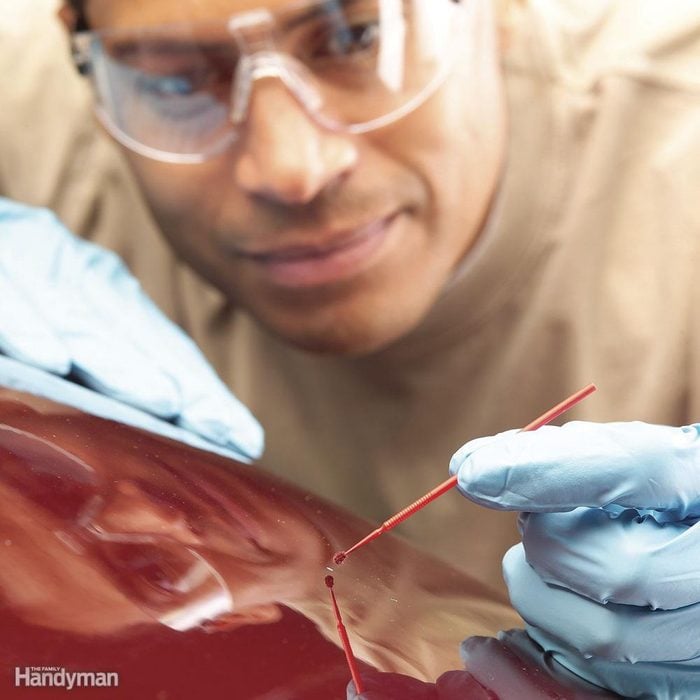 Family Handyman
Family Handyman
How to Touch Up Chipped Auto Paint
If you don't cover paint chips with touch up paint, they'll rust and then you'll have a much bigger problem on your hands. The actual touch up is easy. Just buy touch up paint, fine tip paint applicators and wax and grease remover from any auto parts store. Clean the chip with the wax and grease remover and let it dry. Then dip the applicator in the paint and dab it onto the chip. Don't add too much or the paint will drip. Let it dry completely and apply wax after 30 days. Get the full guide to using auto touch-up paint here.
78 / 105
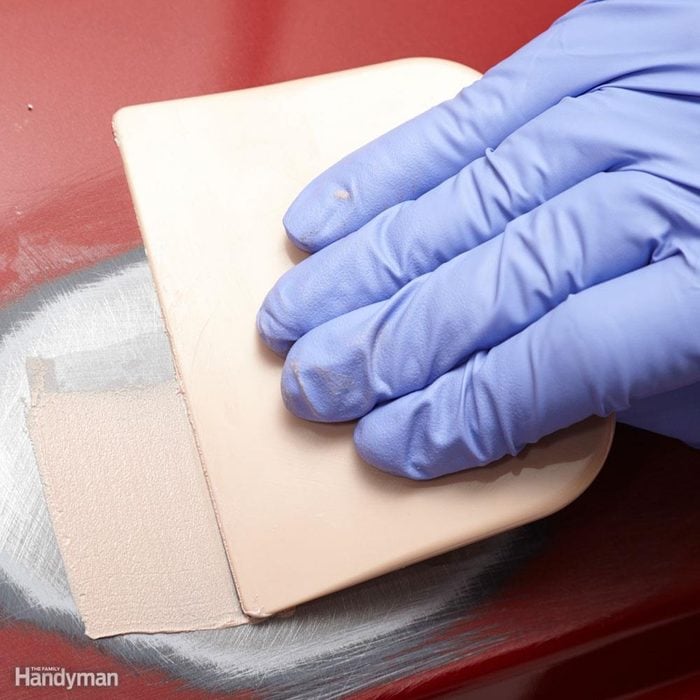 Family Handyman
Family Handyman
Fix Small Dents and Door Dings
If you can patch a wall, you can patch a dent in your car. You'll need various sandpaper grits, a small can of autobody filler and cream paste and plastic applicators. Start by sanding the dent down to bare metal with coarse grit sandpaper. Then feather the edges. Clean the dents with wax and grease remover. Then mix the body filler and apply a very light skim coat to fill in the sandpaper scratches. Allow the filler to set up and then build up the repair with addtional layers no more than 1/4-in. thick per application. Feather the final coat so it levels with the painted areas. After it cures, sand until smooth. Then apply a cream filler to the entire area to fill in any pinholes. Let it cure and do a final sand. Then you can paint the area with touch up paint. Learn more about fixing car dents here.
79 / 105
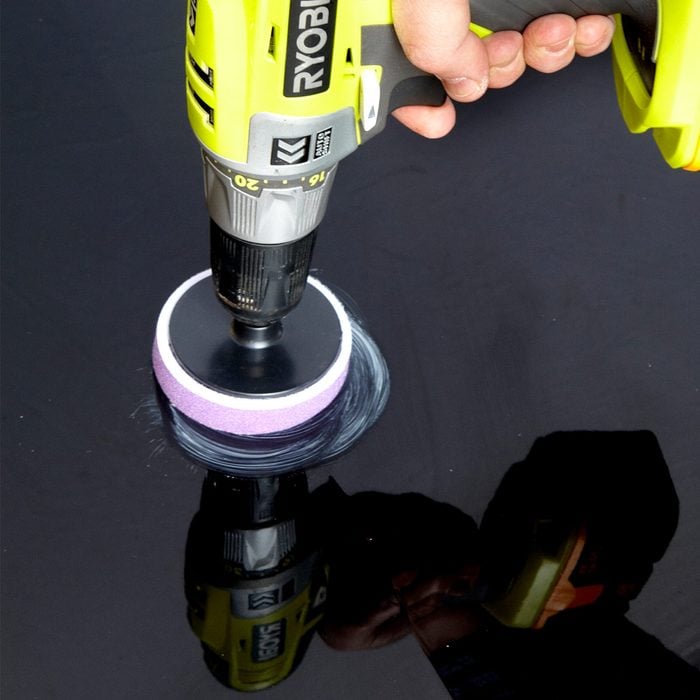
Remove Minor Paint Scratches
80 / 105

Eliminate squeaky doors
If the door squeaks every time you open it, the hinges could be bound by corrosion. If so, squirt the hinges with WD-40 to free them, and move the door several times to work in the lubricant. Once the hinges are in working condition, just squirt them with white lithium grease or motor oil, operate the door several times and then wipe any excess away. Check the door latch for corrosion. Many door latches now have a nonmetallic composite mechanism, which should be lubricated with a shot of silicone spray.
81 / 105
 Family Handyman
Family Handyman
Change Your Oil
One of the most critical maintenance chores for cars is changing the oil regularly. Learn how to change your own oil quickly and without getting too dirty. You'll save money and extend the life of your car by thousands of miles. Here's are the things you do to get an oil change done.
82 / 105
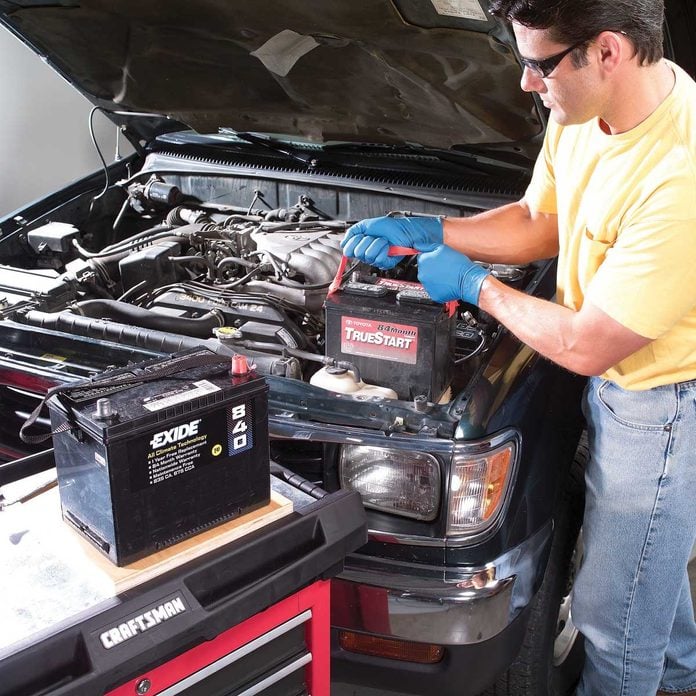 Family Handyman
Family Handyman
Change a Car Battery
Avoid an expensive service or tow charge (and the worry of being stranded!) by keeping your car battery working at peak performance. This article will show you how to perform a simple step-by-step 10-minute seasonal battery check-up so you know whether your battery is performing well. This article will also explain how to replace your battery if it's failing, so you're not left stranded out in the middle of nowhere with a car that won't start.
83 / 105
 wk1003mike/Shutterstock
wk1003mike/Shutterstock
Loose Exhaust Pipes
The classic DIY fix for loose tailpipes has always sort of seemed to be wrapping a coat hanger around the pipe. But these car repairs can be fast.
84 / 105
Seat Belts
Over time seat belts can become less responsive. The simple fix can be just washing the seat belt.
85 / 105
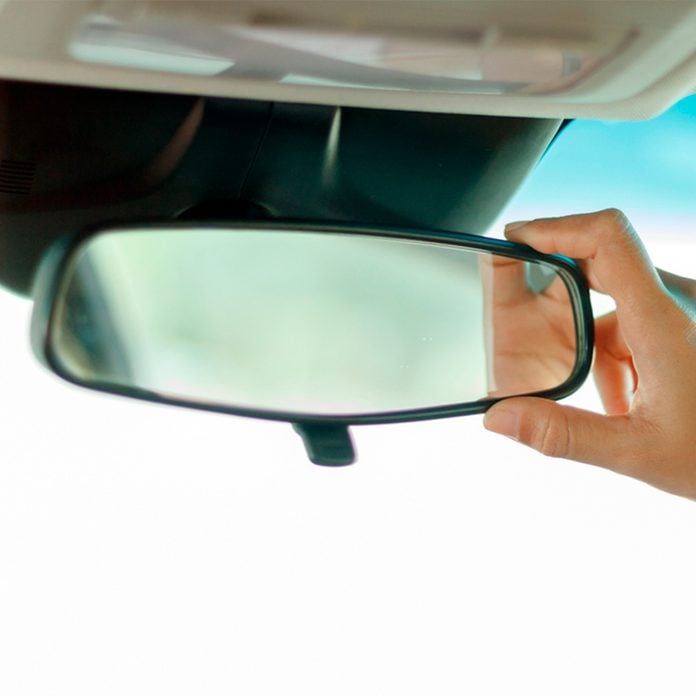 TuiPhotoEngineer/Shutterstock
TuiPhotoEngineer/Shutterstock
Rear View Mirror
Sometimes the adhesive from a rear view mirror will lose its grip and that's when it's time to pick up a kit at an auto parts store. It's a straight forward DIY job. One less of those car repairs to have to pay shop labor costs for.
86 / 105
 Alexandru Nika/Shutterstock
Alexandru Nika/Shutterstock
Speakers
Souping up the sound system of your vehicle is something that can be done relatively easily on your own if you know how to disassemble a door panel and reassemble it. Just do a little research prior to starting the job.
89 / 105
 DuxX/Shutterstock
DuxX/Shutterstock
Fuel Filter
Depending on the location of your fuel filter, changing it can be one of the eaiser car repairs you can do.
90 / 105
 BACHTUB DMITRII/Shutterstock
BACHTUB DMITRII/Shutterstock
Fuel Gauge Sender
If your gas gauge doesn't seem to be accurate you might need to replace the fuel gauge sender. It's one of those car repairs you can do with a little know-how.
91 / 105
 Family Handyman
Family Handyman
Inflate Tires
Inflating car tires is one of those simple car repairs but just be sure to follow the right inflation levels.
92 / 105
 PreechaB/Shutterstock
PreechaB/Shutterstock
Distributor Cap
If your vehicle has a distributor cap it's possible to replace one on your own. It's not one of the things you do to a car that qualifies as a complicated car repair.
93 / 105
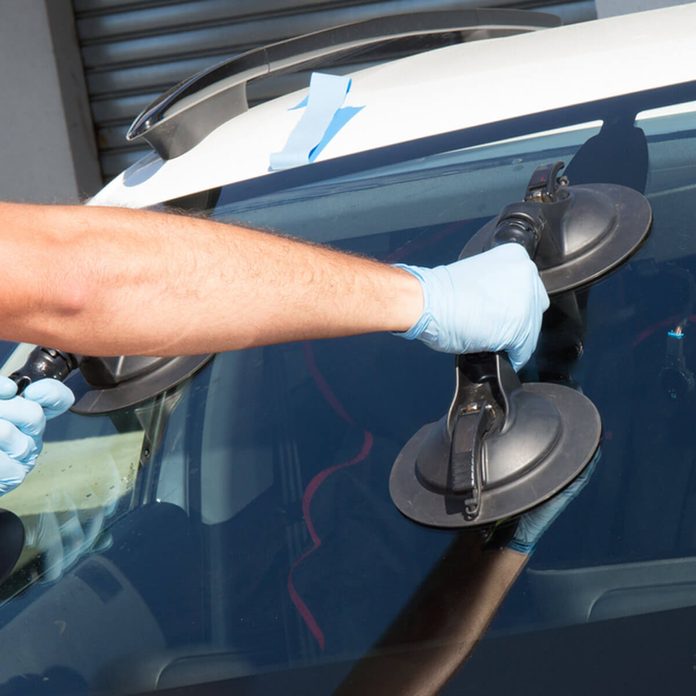 sylv1rob1/Shutterstock
sylv1rob1/Shutterstock
Chipped Windshield
Just as chips in your paint can cause rust, chips in your windshield can spread out into annoying damage, so it's best to fix them right away. The good news is that you can order or pick up windshield repair kits that use resins to block the crack or chip before it causes more damage. With the right tools, you can also replace side power windows!
94 / 105
 Family Handyman
Family Handyman
Plug A Flat
If you're not confident that you or the driver can change a flat tire, one of the things you do is buy two cans of aerosol tire sealer from any auto parts store (Fix-a-Flat is one well-known brand) and keep them in the vehicle. The cans are sold in several sizes for compact, standard and truck-size tires. Tire sealants work on tread punctures 3/16 in. or less in diameter for fast car repairs. They won't work on sidewall punctures, blowouts or any other catastrophic failures. You've got little to lose by trying sealant as one of your car repairs.
95 / 105
 Family Handyman
Family Handyman
Install a Remote Starter
Install a remote starter for your car yourself. It's one of the things you do that works as a great, inexpensive upgrade and a project you can do yourself with simple tools and the supplied wiring diagram.
96 / 105
 Family Handyman
Family Handyman
Spiff Up Your Ride With 3M Car Wrap
If you're just itching to airbrush flames, stripes or logos on your car or truck, put the brakes on the paint and check out "car wrap." 3M vehicle graphics dealers now offer custom design services for 3M's Scotchprint Wrap Films. The dealers will take your design (or help you create one) and fabricate it out of pressure-sensitive film that applies right over your paint. So you can get the look you want without destroying the paint finish. Change your mind and want to go with a different look down the road? Just peel off the old design. Go to 3mgraphics.com/1080 to see all the colors and finishes. Then click on "locate an installer" to find a dealer near you
97 / 105
 Family Handyman
Family Handyman
Set a Spark Plug Gap
Spark plugs don't come gapped for your particular engine. For the best performance, you must gap the plug to the engine manufacturer's specs. If you're buying a plug for a small engine, one of the things you do is ask the parts store to look up the gap size info for you. If the plugs are for your vehicle, find the info in the owner's manual to figure out one of the more important car repairs you can do.. Then adjust the gap as shown in this story.
98 / 105
 Family Handyman
Family Handyman
Silence a Squealing Belt
A squealing belt is a sign of improper belt tension, a misaligned or worn pulley, a worn belt or a sluggish idler roller bearing. Since most late-model vehicles use a spring-loaded self-tensioning mechanism, check that first. Attach a socket or ratchet to the tensioner and rotate it. It should turn smoothly and return to its original position on its own. If you feel any binding or have to manually move it back into position, replace it. If the tensioner checks out, use an automotive stethoscope to identify the source of the squeal. Remove the probe from the end of the stethoscope and hold it next to each belt-driven component while you run the engine. Then listen for the squealing sound. Replace the noisy component.
Never use "belt dressing" to silence a squealing belt. The sticky spray never fixes the root cause of the squeal. Worse yet, the sticky goo collects road dust and sand and grinds up the belt and pulleys. That'll cost you far more when the squeal returns
99 / 105
 Family Handyman
Family Handyman
DIY Paintless Dent Repair
Have you seen those paintless dent repair tools advertised on TV? Do you know anyone who's actually pulled a dent with one? We didn't think so. If you really want to try pulling your own dents for car repairs, consider buying this reasonably priced professional-grade paintless dent removal kit. The Lock Technologies LT-820 ($209 from tooldiscounter.com) comes with two adjustable pry rods, 13 interchangeable tips, a magnetic reflector board and a training DVD. We won't kid you—paintless dent repair is an art. Practice on your kid's junker before tackling the dent on your Cayenne. Body-shop friends tell me that once you've popped about six dents, you'll get the hang of one of the more frustrating car repairs. — Rick Muscoplat
100 / 105
 Family Handyman
Family Handyman
Rescue Those Hoses
After years of being clamped in place, most radiator and heater hoses are usually welded to the pipe. If you want to reuse the hose, you can easily spend 30 minutes finessing the hose off so it's still in good enough condition to reinstall. That's where this cool hose remover tool pays off in car repairs. Just slip the pointed end into the lip of the hose and pull the tool around the pipe. The rounded edge breaks the hose free. Then use the tool to pull the hose off. This baby will save you a lot of time and at least 25 good curse words for later use on a different one of your car repairs.
101 / 105
Replace a Leaking Oil Pressure Switch Yourself with a Special Socket
If your oil light is winking at you, don't assume you need a new oil pump. Instead, head right for the oil pressure switch (usually located near the oil filter). If you can't find yours, consult a shop manual. Know what to do if any of these warning lights come on in your car.
Oil pressure switches are notorious for leaking as they age. When that happens, they send erroneous data to the computer, and you end up with a glowing "oil" light. First, perform a visual check of the switch. If you see fresh oil on it (and it's not leaking from another component above it), it's toast. Replace it. Even if the old unit is dry, it can still be bad. Since a new oil pressure switch costs about $15, it's usually cheaper to replace it yourself than to pay a pro to diagnose it.
However, you will need a special socket. None of your present deep sockets will fit over the sending unit. Buy just a single sending unit socket (Lisle 13250 Oil Pressure Switch Socket; $6 at amazon.com) or a complete set with all the sockets you need to replace oil pressure sending units and oxygen sensors (ATD-5663 7-Piece Oxygen Sensor & Sending Unit set; $52 at amazon.com).
Buy the Lisle Oil Pressure Switch Socket now on Amazon.
Buy the ATD 7-piece Oxygen Sensor and Sending Unit now on Amazon.
102 / 105
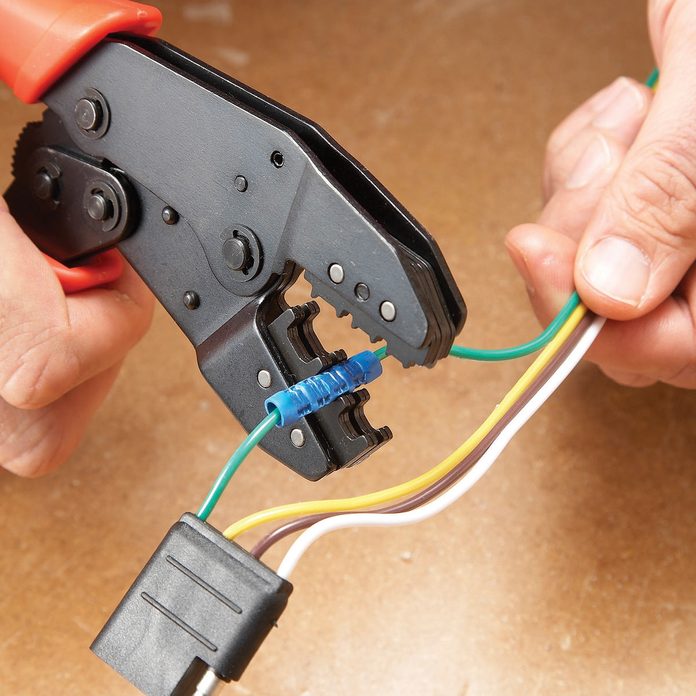 Family Handyman
Family Handyman
How to Splice Automotive Wires
Use a professional crimper and electrical moisture sealant to make quick, solid connections in auto wiring. Here's more on how to splice automotive wires.
103 / 105
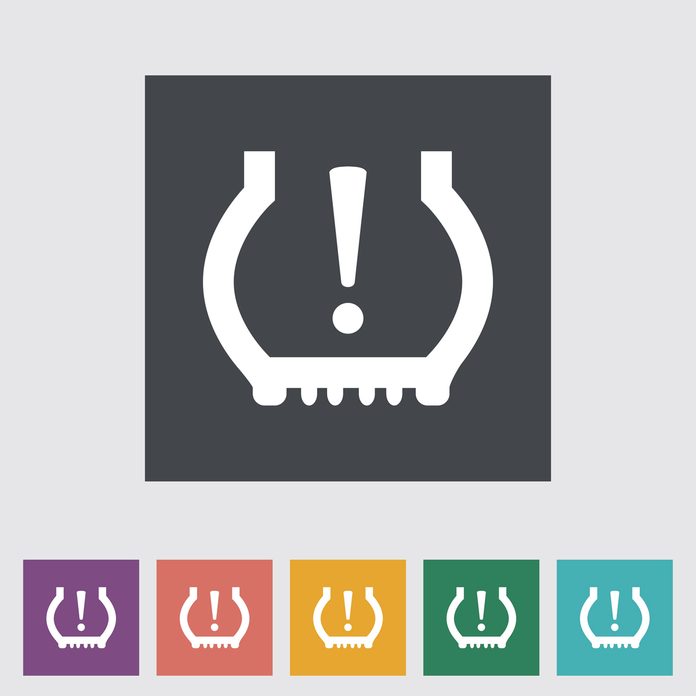 A Aleksii/shutterstock
A Aleksii/shutterstock
Fix a Tire Pressure Sensor Warning Light
Driving with extremely low tire pressure is one of the most common car problems and driving on low tire pressure can put you and your family at risk. That's why all newer vehicles include a Tire Pressure Monitoring System (TPMS).
If you fill your tires to the pressure listed on the label near the driver's door pillar but the light doesn't turn off, here's how to fix the problem.
Drive your car at varying speeds for up to 10 miles to make the light turn off. If the light is still lit, double check the spare tire's pressure. Spare tires usually require a much higher inflation pressure. If it's low, your TPMS light will never turn off. Make sure your tires last with these tips.
104 / 105
 Family Handyman
Family Handyman
Add Graphite to Door Locks
Graphite powder keeps delicate lock mechanism working. We don't think much about our door locks until the key breaks off in the cylinder. Keep these delicate mechanisms moving freely with a blast of dry graphite powder. You may need to push the dust protector flap back slightly with a small metal nail file to get at the lock. A quick pump of the tube will dispense enough graphite. Move the lock cylinder with your key several times to work the graphite into the mechanism. Do this to your trunk lock as well. Check out other amazing ways to loosen up locks on cars.
105 / 105
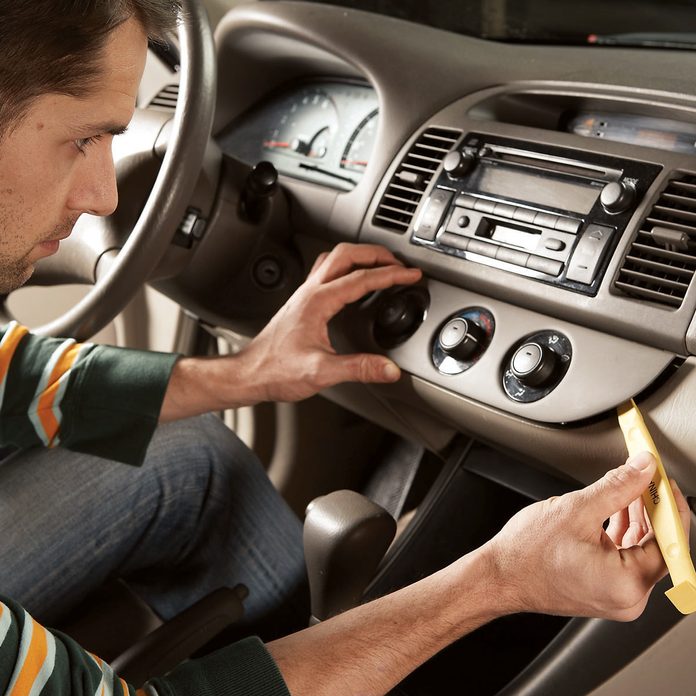 Family Handyman
Family Handyman
Remove a Car Radio
Remove your car radio/CD unit and send it in for repairs rather than buying a new one. The trick is getting it out without wrecking anything. Here's how to replace an old car radio.
Every product is independently selected by our editors. If you buy something through our links, we may earn an affiliate commission.
Originally Published: March 20, 2020
Sign up for DIY projects sent right to your inbox
Complete DIY projects like a pro! Sign up for our newsletter!

Subscribe & SAVE 1 Year Subscription
for only $10!
Do It Yourself Auto Repair Garage
Source: https://www.familyhandyman.com/list/100-super-simple-car-repairs-you-dont-need-to-go-to-the-shop-for/
Posted by: martinezwitow1947.blogspot.com

0 Response to "Do It Yourself Auto Repair Garage"
Post a Comment